- Home
- >
- Vector Addition – Explanation and Examples
JUMP TO TOPIC
Vector Addition – Explanation & Examples
 Like scalar addition, vector addition involves putting two or more vectors together. More specifically, when you add vectors, you are:
Like scalar addition, vector addition involves putting two or more vectors together. More specifically, when you add vectors, you are:
“Adding the two or more vectors using the addition operation to get a new vector equal to the sum of the two or more vectors.”
In this topic, we will discuss the vectors addition from the following aspects:
- What is Vector Addition?
- How to Add Vectors Graphically
- How to Add Two Vectors
What is Vector Addition?
Two vectors, A and B, can be added together using vector addition, and the resultant vector can be written as:
R = A + B
How to Add Vectors Graphically
We have to consider both components of a vector, namely direction and magnitude when using vector addition.
Keep in mind that the two vectors with the same magnitude and direction can be added like scalars.
In this topic, we will explore graphical and mathematical methods of vector addition, including:
- Vector Addition Using the Head-to-Tail Rule
- Vector Addition Using the Parallelogram Method
- Vector Addition Using the Components
Vector Addition Using the Head-to-Tail Rule
Vector addition can be performed using the famous head-to-tail method. According to this rule, two vectors can be added together by placing them together so that the first vector’s head joins the tail of the second vector. The resultant sum vector can then be obtained by joining the first vector’s tail to the head of the second vector. This is sometimes also known as the triangle method of vector addition.
Vector addition using the head-to-tail rule is illustrated in the image below. The two vectors P and Q are added using the head-to-tail method, and we can see the triangle formed by the two original vectors and the sum vector.
First, the two vectors P and Q are placed together such that the head of vector P connects the tail of vector Q. Next, to find the sum, a resultant vector R is drawn such that it connects the tail of P to the head of Q.
Mathematically, the sum, or resultant, vector, R, in the image below can be expressed as:
R = P + Q
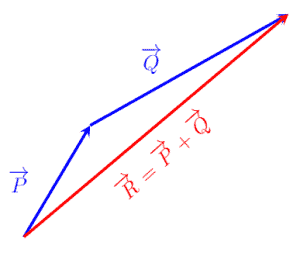
Vector Addition Using the Parallelogram Method
To understand vector addition using the parallelogram method, we will consider and explain the figure below.
First, draw the given vectors, A and B, to have the same initial point as shown in the image below. Then, draw a parallelogram using the copies of the given vectors.
Second, draw the copy of the vector B called B’, and place it parallel to the vector B to connect to the head of the first vector, A. Similarly, draw a copy of the vector A called A’, and place it parallel to A so that its tail connects with the head of vector B.
Finally, the resultant of the two vectors, which is equal to the sum of vectors A and B, will be the parallelogram’s diagonal. It can be drawn by joining the initial point of the two vectors A and B to the head of the vectors A’ and B’.
In summary, three steps are required to perform the vector addition using the parallelogram method:
Step 1: Place the two vectors so that they have a common starting point
Step 2: Draw and complete the parallelogram using copies of the two original vectors
Step 3: The diagonal of the parallelogram is then equal to the sum of the two vectors
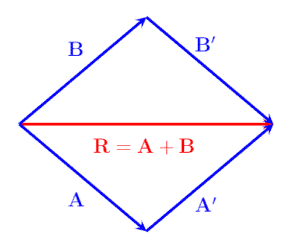
Vector Addition Using the Components
As we know, vectors given in Cartesian coordinates can be decomposed into their horizontal and vertical components. For example, a vector P at an angle Φ, as shown in the image below, can be decomposed into its components as:
Px, which represents the component of vector P along the horizontal axis (x-axis), and
Py, which represents the component of vector P along the vertical axis (y-axis).
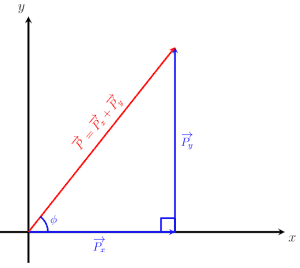
It can be seen that the three vectors form a right triangle and that the vector P can be expressed as:
P = Px + Py
Mathematically, the components of a vector can be also be calculated using the magnitude and the angle of the given vector.
Px = P cos Φ
Py = P sin Φ
Moreover, we can also determine the resultant vector if its horizontal and vertical components are given. For example, if the values of Px and Py are given, then we can calculate the magnitude and the angle of the vector P as follows:
|P| = √ (Px )^2+( Py)^2
And the angle can be found as:
Φ = tan-1 (Py/ Px)
Thus, in summary, we can determine a resultant vector if its components are given. Alternatively, if the vector itself is given, we can determine the components using the above equations.
Similarly, if the vectors are expressed in ordered pairs (column vectors), we can perform the addition operation on the vectors using their components. For example, consider the two vectors M and N given as:
M = (m1, m2)
N = (n1, n2)
Performing vector addition on the two vectors is equivalent to adding the two vectors’ respective x and y components. This yields the resultant vector S:
S = M + N
S = (m1+n1, m2+ n2).
It can be written explicitly as:
Sx = m1 + n1
Sy = m2 + n2.
The magnitude of the resultant vector S can be computed as:
|S| = √ (Sx )^2+( Sy)^2
And the angle can be computed as:
Φ = tan-1 (Sy/ Sx).
How to Add Two Vectors
This section will discuss examples of vector addition and their step-by-step solutions to get some practice using the different methods discussed above.
Examples
Example 1
Given that the two vectors, A and B, as shown in the image below, graphically determine their sum using the head-to-tail method.
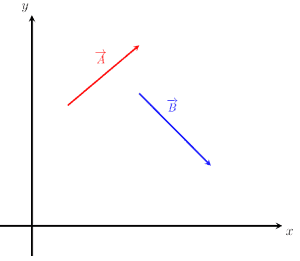
Solution
The first step of the head-to-tail method is placing the given vectors A and B such that the tail of vector B connects to the head of vector A, as shown in the image below. Next, to find their sum, we draw a resultant vector R so that it connects the tail of vector A to the head of vector B. Mathematically, the resultant can be expressed as:
R = A + B
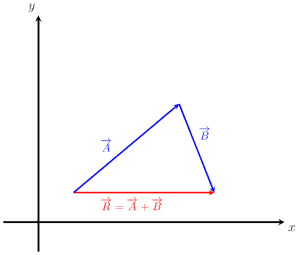
Example 2
Given the two vectors, AB = (3, 2) and BC = (2, 2), determine their sum using the head-to-tail rule.
Solution
AB + BC = (3, 2) + (2, 2)
AB + BC = (3 + 2, 2 + 2)
AB + BC = (5, 4).
Or as shown in the image below, the resultant vector can be written as:
AC = (5, 4)
Note: To use the triangle rule/head-to-tail rule, the intermediate letter of the two vectors being added must be the same:
AC = AB + BC
In this example, the intermediate letter is B.
The magnitude of the resultant vector AC can be found as follows:
|AC| = √ (ACx) ^ 2 + (ACY )^2
|AC| = √ (5) ^ 2 + (4)^2
|AC| = √ 25 + 16
|AC| = 6.403 units (approximately).
The angle of the resultant vector AC can be found as follows:
Φ = tan-1 (ACy/ ACx)
Φ = tan-1 (4/5)
Φ = tan-1 (4/5)
Φ = 38.66 degrees
Example 3
Given two vectors, S = 10 m, Φ = 30 degrees and T = 20m, Φ = 60 degrees, determine their sum. Then, calculate the magnitude and the angle of the resultant vector using the component method.
Solution
Let R be the resultant vector equal to the sum of the given vectors, which can be expressed as:
R = S + T
To use the component method, we first look at the component parts of the given vectors. The horizontal component of S is:
Sx = S Cos Φ
Sx = 10 Cos 30
Sx = 8.660 m (Approximately)
Similarly, for the vertical component:
Sy = S Sin Φ
Sy = 10 Sin 30
Sy = 5 m
Next, we compute the components of vector T:
Tx = T Cos Φ
Ty = T Sin Φ
Where,
Tx = 20 Cos 60
Tx = 10m
Ty = 20 Sin 60
Ty = 17.320 (approximately)
Now, we can compute the sum vector by adding the individual x and y components of the S and T vector as follows:
Rx = Sx + Tx
Rx = 8.660 + 10
Rx = 16.660 m
Ry = Sy + Ty
Ry = 5 + 17.32
Ry = 22.320 m
The resultant vector R can be expressed in column form as:
R = (16.66, 22.32).
Finally, the magnitude and the angle of the resultant vector can be found as:
|R| = √ (16.66) ^ 2 + (22.32)^2
|R| = 23.292 m (Approximately)
Φ = tan-1 (Ry/Rx)
Φ = tan-1 (22.32/16.66)
Φ = 53.26 degrees (Approximately)
Thus, the resultant sum vector is:
R = 23.292 m, Φ = 53.26 degrees.
Example 4
A traveler walks P = 20 m straight west and then Q = 10 m straight north. Determine how far the traveler is from the starting point. Also, give the magnitude and angle of the resultant vector.
Solution
First, we graphically represent the given displacement vectors P and Q and then draw their resultant vector using the head to tail rule, as shown in the image below. It is obvious from the image that the traveler covered a distance equal to the magnitude of the vector R from the starting point.
Now, to mathematically compute the resultant vector, we use the following formulas:
R = P + Q
|R| = √ (20) ^ 2 + (10)^2
|R| = 22.36 m (Approximately)
And the angle can be computed as:
Φ = tan-1 (10/20)
Φ = 26.57 degrees
Thus, the traveler covered a distance of 22.36 m from the starting point at an angle of 26.57 degrees to the northwest.
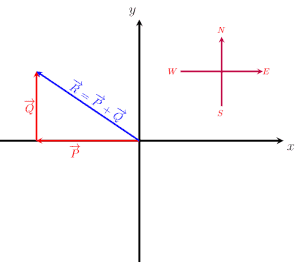
Example 5
Determine the resultant sum vector for the two vectors A = (-5, -1) and B = (2, -1).
Solution
The given vectors are already in their component form, so we first determine their angles.
For the vector A:
Φ = tan-1 (Ay/Ax)
Φ = tan-1 (-1/-5)
Φ = 11.31 degrees.
For the vector B:
Φ = tan-1 (By/Bx)
Φ = tan-1 (-1/2)
Φ = -26.57 degrees.
Next, we find the resultant vector by adding the individual components:
S = A + B
Sx = Ax + Bx
Sx = -5 + 2
Sx = -3
Sy = Ay + By
Sy = -1 -1
Sy = -2
The resultant vector S can be expressed as the column vector:
S = (-3, -2).
Finally, the magnitude and the angle of the resultant vector are:
|S| = √ (-3) ^ 2 + (-2)^2
|S| = 3.605 units (Approximately)
Φ = tan-1 (Sy/Sx)
Φ = tan-1 (-2/-3)
Φ = 33.69 degrees
Thus, the resultant sum vector is:
S = 3.605 units, Φ = 33.69 degrees.
Example 6
Given the two vectors PQ and QR, as shown in the image below, calculate their sum’s value, the vector PR.
Solution
From the given image, the resultant vector can be given as:
PQ + QR = (2, 3) + (2, -2)
PQ + QR = (4, 1).
It can also be written as:
PR = (4, 1)
The magnitude of the resultant vector PR can be found using the following equations:
|PR| = √ (4) ^ 2 + (1)^2
|PR| = √ 17
|PR| = 4.123 units (Approximately)
The angle of the resultant vector PR can be found as follows:
Φ = tan-1 (1/4)
Φ = 14.04 degrees
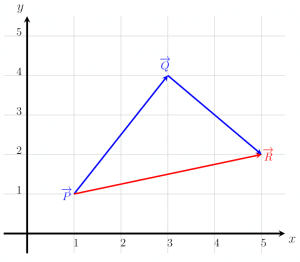
Practice Questions
- Given two vectors, V = (2, 5) and C = (3, -2), determine their sum using the head-to-tail rule. Also, determine the magnitude and angle of the resultant vector, R.
- Given the two vectors G = (5, 5) and H = (4, -10), determine their sum using the head-yo-tail rule. Also, determine the magnitude and angle of the resultant vector, P.
- Given the vectors OA, where O = (-1, 3) and A = (5,2), and the vector UV, where U = (1, -2) and V = (-2,2), determine the resultant sum vector S. Then, find its magnitude and angle.
- Given the quadrilateral ABCD, determine the following:
- DC + CA = ?
- BD + DC = ?
- AD + DC = ?
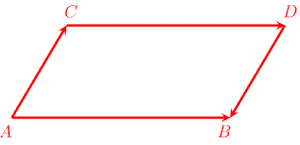
- M = 10 m East and N = 15 m North. Determine the sum of the two vectors, then find the magnitude and angle of the resultant vector.
Answers
- The resultant vector R is R = (5, 3), the magnitude of R is |R| = 5.830 units, and the angle is Φ = 30.96 degrees.
- The resultant vector P is P = (9, 5), the magnitude of P is |P| = 10. 30 units, and the angle is Φ = 29.05 degrees.
- The vectors are OA = (6, -1) and UV = (-3, 4), the resultant sum vector S is given as S = (3, 3), magnitude of S is |S| = 4.242 units and the angle is Φ = 45 degrees.
- In the given quadrilateral, the sum is computed as:
DC + CA = DA
BD + DC = BC
AD + DC = AC
- The resultant of the two vectors is:
R = M + N
|R| = 18.027 m,
And the angle can be computed as:
Φ = tan-1 (15/10)
Φ = 56.30 degrees.
Thus, the resultant vector is R = 18.027 m, Φ = 56.30 degrees Northeast.
